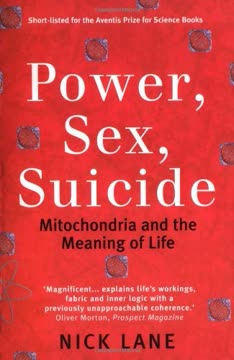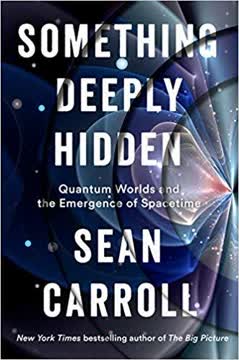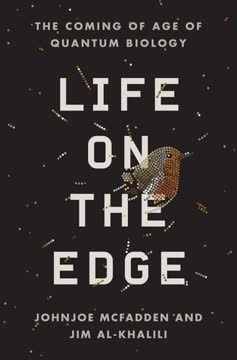Key Takeaways
1. Quantum mechanics underlies life's most fundamental processes
Life appears to have one foot in the classical world of everyday objects and the other planted in the strange and peculiar depths of the quantum world.
Quantum-classical boundary. Life operates at the intersection of the quantum and classical realms. While classical physics governs macroscopic biological processes, quantum effects play crucial roles at the molecular level. This quantum-classical interface allows living systems to harness the strange properties of the quantum world while maintaining order and stability at larger scales.
Amplification of quantum effects. Biological systems have evolved mechanisms to amplify and utilize quantum phenomena in ways not seen in non-living matter. Through carefully tuned molecular structures and processes, quantum effects that are typically masked at macroscopic scales become functionally relevant in living organisms. This unique capability sets life apart from inanimate matter and may be key to understanding its emergence and complexity.
2. Enzymes harness quantum tunneling for efficient catalysis
To observe the quantum weirdness you either have to go to unusual places (such as the interior of the sun), peer deep into the microworld (with instruments like electron microscopes) or carefully line up the quantum particles so that they are marching in step.
Quantum tunneling in enzymes. Enzymes, the biological catalysts essential for life, utilize quantum tunneling to dramatically accelerate chemical reactions. This process allows particles like protons and electrons to "tunnel" through energy barriers they classically could not surmount. By precisely aligning reactants and creating optimal conditions for tunneling, enzymes achieve reaction rates far beyond what classical models predict.
Experimental evidence. Studies using kinetic isotope effects have provided strong evidence for quantum tunneling in enzymatic reactions. By replacing hydrogen atoms with heavier isotopes like deuterium, researchers have observed changes in reaction rates consistent with tunneling predictions. This quantum effect allows enzymes to catalyze reactions orders of magnitude faster than would be possible through classical means alone.
3. Photosynthesis employs quantum coherence to capture light energy
The quantum beats that Fleming's group had discovered in the FMO complex were indeed a signature of quantum coherence, and Lloyd concluded that the chlorophyll molecules were operating a novel search strategy known as a quantum walk.
Quantum coherence in photosynthesis. Photosynthetic organisms use quantum coherence to efficiently capture and transport light energy. When a photon is absorbed, it creates an exciton - a quantum superposition state that can simultaneously explore multiple pathways to find the most efficient route to the reaction center. This quantum walk allows for remarkably efficient energy transfer, approaching 100% efficiency in some systems.
Experimental observations.
- Quantum beating observed in photosynthetic complexes
- Coherence maintained for surprisingly long times at physiological temperatures
- Evidence found in diverse organisms from bacteria to plants
These findings challenge the notion that quantum effects are too fragile to persist in warm, wet biological environments and suggest that life has evolved to exploit quantum phenomena for critical functions.
4. Quantum effects may enable the sense of smell
If quantum smelling is found in such a range of creatures it is likely to be very widespread. Humans, fruit flies, anemonefish and a host of other animals are probably harnessing the ability of an electron to vanish from one point in space and instantly materialize in another so that they can capture that "message from a material reality" and find food, or a mate—or their way home.
Vibrational theory of olfaction. The sense of smell may rely on quantum mechanical processes to distinguish between different odor molecules. According to this theory, olfactory receptors detect molecular vibrations rather than just molecular shape. These vibrations facilitate inelastic electron tunneling, allowing the receptor to identify specific odorants.
Supporting evidence:
- Ability to distinguish between molecules with identical shapes but different vibrations
- Deuterated compounds smell different despite identical shapes
- Flies can be trained to recognize specific molecular vibrations
While still controversial, the quantum theory of smell offers a compelling explanation for the exquisite sensitivity and discriminatory power of olfaction across many species.
5. Magnetoreception in birds likely relies on quantum entanglement
Schulten proposed that pairs of free radicals generated by a process known as a fast triplet reaction could have their corresponding electrons "quantum entangled."
Radical pair mechanism. Birds and other animals may use quantum entanglement to detect the Earth's magnetic field for navigation. This process involves light-activated proteins called cryptochromes creating entangled electron pairs. The quantum state of these pairs is influenced by the orientation of the magnetic field, potentially providing directional information.
Experimental support:
- Disruption of bird navigation by weak oscillating magnetic fields
- Genetic evidence linking cryptochromes to magnetoreception
- Similar mechanisms found in diverse species from insects to mammals
This quantum compass theory offers a fascinating example of how life may exploit subtle quantum effects for macroscopic functions like long-distance navigation.
6. DNA replication and mutation involve quantum phenomena
Tautomers—with alternative proton positions—appear to be a driver of mutation, and thereby of evolution; but what makes protons move to the wrong position?
Quantum basis of genetics. The genetic code itself may have quantum roots. The precise positioning of protons in DNA base pairs, which determines the genetic information, is governed by quantum mechanics. Quantum tunneling of these protons can lead to rare tautomeric forms of DNA bases, potentially causing mutations.
Implications:
- High fidelity of DNA replication relies on quantum effects
- Mutations, the raw material for evolution, may have a quantum origin
- Quantum phenomena could influence the rate and nature of genetic changes
Understanding the quantum nature of DNA may provide new insights into the mechanisms of evolution and the fundamental processes of life.
7. Consciousness may have quantum roots
Quantum mechanics allows particles to "walk through walls" and to be in two places at once, possess spooky connections and travel through apparently impenetrable barriers. Life appears to have one foot in the classical world of everyday objects and the other planted in the strange and peculiar depths of the quantum world.
Quantum consciousness theories. Some researchers propose that quantum processes in the brain may underlie consciousness. These theories suggest that quantum coherence or entanglement in neural structures could explain phenomena like subjective experience and the binding problem - how disparate information is integrated into a unified conscious experience.
Potential mechanisms:
- Quantum effects in microtubules within neurons
- Coherent ion channels influencing neural signaling
- Electromagnetic fields generated by coherent neural activity
While highly speculative and controversial, these ideas highlight the potential for quantum mechanics to shed light on one of science's greatest mysteries - the nature of consciousness itself.
8. The origin of life potentially involved quantum searching
If the search for the first self-replicator was performed in the quantum rather than the classical world, it does at least potentially solve the self-replicator search problem.
Quantum origin of life. The emergence of the first self-replicating molecules may have been facilitated by quantum processes. In this scenario, proto-replicator molecules could have explored vast numbers of potential configurations through quantum superposition, dramatically increasing the chances of stumbling upon a self-replicating arrangement.
Quantum advantage:
- Simultaneous exploration of multiple molecular configurations
- Rapid "quantum walks" through chemical possibility space
- Potential to overcome seemingly insurmountable probabilistic barriers
While speculative, this quantum approach to the origin of life offers a potential solution to the long-standing problem of how complex, self-replicating systems could have arisen from a prebiotic soup through random processes alone.
Last updated:
FAQ
What's Life on the Edge: The Coming of Age of Quantum Biology about?
- Exploration of Quantum Biology: The book explores the intersection of quantum mechanics and biology, examining how quantum phenomena influence biological processes.
- Focus on Living Organisms: It investigates how organisms like birds and plants use quantum effects for navigation and photosynthesis, suggesting life operates at the "quantum edge."
- Interdisciplinary Approach: Written by Johnjoe McFadden and Jim Al-Khalili, it combines insights from physics, biology, and chemistry to make complex concepts accessible.
Why should I read Life on the Edge: The Coming of Age of Quantum Biology?
- Innovative Perspective: The book challenges traditional views by integrating quantum mechanics into biology, offering a fresh perspective on life.
- Engaging Narratives: It uses real-world examples and storytelling to make complex scientific concepts relatable and easier to understand.
- Implications for Future Research: It provides insights into future scientific research, particularly in quantum biology and biotechnology, with potential applications in medicine and technology.
What are the key takeaways of Life on the Edge: The Coming of Age of Quantum Biology?
- Quantum Mechanics in Biology: Quantum mechanics plays a crucial role in biological processes, challenging the notion that biology is purely classical.
- Complexity of Life: Life is a product of both classical and quantum processes, requiring a multidisciplinary approach for full understanding.
- Future of Quantum Biology: The field could lead to revolutionary changes in technology and our understanding of consciousness.
What are the best quotes from Life on the Edge: The Coming of Age of Quantum Biology and what do they mean?
- “Life appears to have one foot in the classical world and the other planted in the strange and peculiar depths of the quantum world.”: This highlights the book's theme that understanding life requires both classical and quantum principles.
- “Quantum mechanics is normal. It is the world it describes that is weird.”: This challenges readers to reconsider their perceptions of quantum mechanics and the natural world.
- “Life’s deep roots allow it to harness those weird phenomena that prowl the quantum edge.”: It emphasizes the intricate connection between life and quantum mechanics.
How does quantum mechanics influence biological processes in Life on the Edge: The Coming of Age of Quantum Biology?
- Photosynthesis Efficiency: Quantum coherence allows plants to capture and transfer energy from sunlight with near-perfect efficiency.
- Magnetoreception in Animals: Quantum entanglement helps animals like birds navigate using the Earth's magnetic field.
- Enzyme Functionality: Quantum tunneling enables enzymes to catalyze reactions more efficiently than classical processes would allow.
How does Life on the Edge: The Coming of Age of Quantum Biology explain photosynthesis using quantum mechanics?
- Exciton Energy Transfer: Chlorophyll molecules capture light energy and transfer it efficiently to reaction centers using quantum coherence.
- Quantum Beats: Excitons follow multiple paths simultaneously, enhancing energy transfer efficiency in photosynthesis.
- Role of Quantum Coherence: It maintains photosynthesis efficiency, allowing near 100% conversion of sunlight into chemical energy.
What is magnetoreception and how is it explained in Life on the Edge: The Coming of Age of Quantum Biology?
- Ability to Sense Magnetic Fields: Certain animals detect the Earth's magnetic field for navigation, linked to quantum processes.
- Role of Cryptochrome: Light-sensitive proteins interact with magnetic fields, possibly involving quantum entanglement and coherence.
- Experimental Evidence: Studies show animals navigate using magnetic senses, supporting the quantum mechanism theory.
What role do enzymes play in quantum biology according to Life on the Edge: The Coming of Age of Quantum Biology?
- Catalysts for Biological Reactions: Enzymes facilitate biochemical reactions by lowering activation energy.
- Quantum Tunneling Mechanism: Some enzymes use quantum tunneling to transfer electrons and protons, enhancing catalytic efficiency.
- Choreographed Molecular Motion: Enzymes maintain quantum coherence through precise molecular motions, crucial for their function.
How does Life on the Edge: The Coming of Age of Quantum Biology address the concept of life itself?
- Defining Life: The authors explore characteristics distinguishing living organisms from inanimate matter, emphasizing complexity.
- Quantum Edge of Life: Life operates at the quantum edge, where quantum mechanics influences biological processes.
- Implications for Understanding Life: Understanding life requires considering quantum effects, leading to new insights into living systems.
What challenges does Life on the Edge: The Coming of Age of Quantum Biology present to traditional views of biology?
- Integration of Disciplines: It advocates for combining physics and biology to understand life fully.
- Complexity of Life: Life involves quantum phenomena, requiring a reevaluation of classical biological studies.
- Implications for Consciousness: It raises questions about consciousness and its potential quantum underpinnings.
How does Life on the Edge: The Coming of Age of Quantum Biology connect quantum biology to technology?
- Synthetic Biology: Quantum biology could inform the creation of new life forms in synthetic biology.
- Quantum Computing: Insights from quantum biology might enhance computational efficiency in quantum computing.
- Biomimetic Technologies: Technologies inspired by biological processes could benefit from quantum principles, improving efficiency.
What are the implications of quantum biology for future research according to Life on the Edge: The Coming of Age of Quantum Biology?
- New Research Directions: Quantum biology opens new avenues for understanding complex biological processes.
- Potential for Technological Advances: It may inspire new technologies, such as efficient solar cells or quantum computers.
- Interdisciplinary Collaboration: Encourages collaboration between physicists, biologists, and chemists for innovative research.
Review Summary
Life on the Edge explores quantum biology, examining how quantum effects may influence biological processes. Reviewers praise the book's accessibility and fascinating subject matter, though some find certain sections overly simplified or repetitive. The authors present evidence for quantum phenomena in photosynthesis, bird navigation, and other biological systems. While some readers found the technical details challenging, many appreciated the book's clear explanations and thought-provoking ideas. Overall, reviewers consider it an intriguing introduction to an emerging field of science.
Similar Books








Download PDF
Download EPUB
.epub digital book format is ideal for reading ebooks on phones, tablets, and e-readers.




